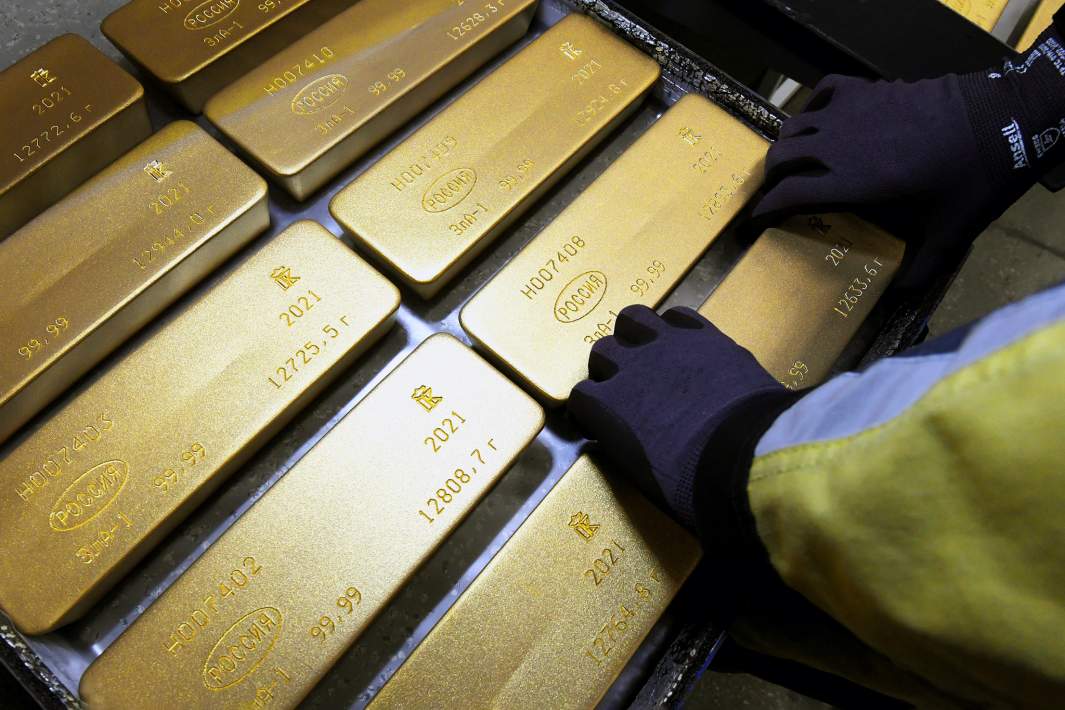
Russia's gold reserves reach record levels
By Rhod Mackenzie
Russia's gold reserves stood at 2,332 tonnes at the end of last year - an all time record level, which according to the World Gold Council. Russia continues to rank fifth in the world in gold reserves. This trend is explained by the country's abandonment of toxic reserve currencies. However, unlike the dollar and the euro, the precious metal does not pay dividends, analysts point out. However,gold has always been a defensive asset. Its price has risen 8% this year to $1,963 an ounce. Is it worth it to increase reserves, or is it better to use this money in the economy?
Russia's reserves
Russia's gold reserves at the end of 2022 amounted to 2,332 tonnes. This is a record level since the World Gold Council (WGC) began tracking this indicator in 2000 Back then in 2000, Russia's precious metal reserves amounted to only 384 tonnes.
At the end of last year, the Russian Federation ranked fifth in terms of gold reserves. The USA (8133 tonnes), Germany (3355 tonnes), Italy (2451 tonnes) and France (2436 tonnes) had more precious metal in their reserves.
During 2022 the Bank of Russia did not disclose the volume of the main precious metal in reserves, but then the publication of statistics resumed. The last time the figure was announced was at the end of March 2023 - then they amounted to 2329.65 tonnes. As of 1 September, the international reserves of the Russian Federation amounted to $581.6 billion, including $144.7 billion in monetary gold.
The entire volume of precious metal from Russia's international reserves is held in the Central Bank's vaults in the country, the regulator announced in March last year. At the end of February, the United States and the EU froze part of the international reserves of the Bank of Russia in response to the start of a special military operation in Ukraine. The regulator estimated their size at around $300 billion.
Amid the geopolitical instability, central banks increased their gold reserves by 228 tonnes in the first three months of 2023, according to the World Council. This was a record for the first quarter since the statistics began in 2000. According to analysts, more countries are repatriating precious metal reserves after the West imposed sanctions on the Russian Federation.
Strategy review
The increase in geopolitical tensions against the backdrop of the conflict between Russia and Western countries has led to a review of currency risks by many national regulators, said Alexander Potavin, an analyst at Finam Financial Group. Storing reserves in various protective assets, such as gold, reduces the likelihood of devaluation, withdrawal and other problems, he noted.
- It is a very specific type of asset. It does not pay dividends or coupons, it has isecure storage requirements and the metal has limited liquidity. However, it can help when financing from other sources is difficult," Alexander Potavin said.
Since the beginning of the year, the price of the main precious metal has risen by about 8%. On 20 September it was trading at $1,963 an ounce, compared with $1,800 at the end of 2002.
Alexander Potavin recalled that in August the National Welfare Fund (NWF) sold 385.2 million yuan and 570.2 kg of gold for a total of 8.2 billion roubles. The proceeds were used to finance the budget deficit; as a result of the transactions, 508.3 tonnes of gold remained in the NWF account, he added.
- The purposeful creation of significant reserves of the precious metal means that the country does not spend a large amount of money on its development, but puts it in a box. The authorities often do this when they see growing geopolitical risks for themselves," Alexander Potavin sums up.
What does this mean for the country's economy?
As a major gold-producing country, Russia has always had a significant share of the metal in its reserves, noted Anton Tabakh, chief economist at the Expert RA rating agency. For the Russian Federation, the dollar and the euro have become "toxic", so reserves are now being accumulated in precious metals and the yuan.
- Sanctions are unlikely to be lifted any time soon, so the upward trend in reserves should continue. Gold is not the best investment, but it is not the worst either, but the reason for the increase in reserves is unlikely to inspire optimism, he said.
An additional reason for the increase in Russia's gold reserves was the expectation of the likely emergence of a single currency of the BRICS countries, which will be backed by precious metals, said Freedom Finance Global analyst Vladimir Chernov.
He noted that, according to the Central Bank, as of 1 September 2023, in the structure of Russia's international reserves, 75% is occupied by currency and 24.88% by monetary gold.
"There is virtually no doubt that in the near future Russia will move up in the ranking of countries in terms of accumulated gold, because other states, unlike the Russian Federation, still use dollars and euros to replenish their gold and currency reserves," he said.
There is no point in buying a lot of yuan for reserves, as a large amount is simply not needed for foreign trade with this country," Vladimir Chernov explained.
At the end of 2022, the Finance Ministry approved a new structure for the National Welfare Fund, raising the maximum share of reserves in gold to 40%. Previously, the Ministry and the Central Bank followed the recommendation of the IMF, according to which the share of precious metals in the total volume of gold and currency reserves should not exceed 20%, recalls Evgeniy Mironyuk, stock market expert at BCS World of Investments.
Now, in essence, the Central Bank can operate only in the yuan, ruble, gold and financial instruments in these assets, he added.
